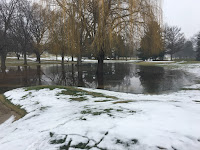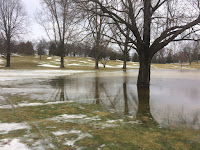It's always hard to spend time making a blog update with so much going on with the course. With the recent stretch of rainy weather all of us at the shop have had a chance to get caught up with various odds and ends inside. It also gives me this opportunity to say a little about all that has been going on outside.
Fairway aerification was successfully completed on April 23rd and 24th. Everything went perfectly for us. The weather was ideal leading into Sunday night and continued into Monday, allowing the cores to perfectly dry before we ground them up. The rain that followed later in the week was also perfect for washing in any remaining soil. The almost unrelenting rain we have been getting since isn't great for playing but it won't negatively impact the fairways in the long run.
We have been mowing the greens, tees, fairways and rough as needed. It has been a really good spring for root growth on most of the greens. Many times when I take a plug out while setting cups it looks like something out of a textbook. It's too early to tell what kind of summer we will have but we should be going in strong.
Dr. Williamson and Dr. Hogg have been out multiple times to monitor the bee hives on 3. The first few trips they supplied the bees with a simple mix of sugar and water to ensure they had a supply of food. On the most recent trip they also brought a frame with honey for each hive. They were very encouraged with the hive progress as the bees had already begun forming some comb.
The bees aren't the only new wildlife at Blackhawk. Late one morning I spotted what I believe is a great horned owl on the ground at the back of the range.
I also snapped this picture of of a butterfly off the right side of 12 green.
My Google searching leads me to believe it is a Spicebush Swallowtail. The Blue Bird house on the back side of the bathrooms on 6 also has a resident pair of Blue Birds. It's amazing to see the variety of birds that call Blackhawk home.
We have already had a few of our older part-timers come in to help as needed. A lot of what we are able to get done is thanks to their help. In the coming weeks we will also see our summer roster filled out. We are happy to have a few people returning from last year and hope to have the new crew members trained before June.
If you have already had a chance to play this year I hope you enjoyed your time. If you haven't played yet now is a perfect time to enjoy a round; if you are anything like me it's the best time of year for golf as the trees don't have many leaves and my errant shots go a bit further. Thanks for reading and I hope to see you out and about on the course.
Welcome to the Blackhawk Country Club Greens & Grounds Department blog. This blog will provide periodic updates and information relating to course projects, agronomic practices, and general maintenance that occurs on the golf course. Please, feel free to leave a comment and return often.
Monday, May 1, 2017
Wednesday, March 1, 2017
Honeybees at Blackhawk Country Club
The value and perception of golf courses can be enhanced by
promoting their beneficial impacts on wildlife and ecosystems. Golf course
managers can provide safe havens for a wide range of wildlife through careful
planning and partnerships. They can also play a critical role in leading the
initiative to promote and protect many wildlife species. The growing
development of housing and commercial space, coupled with the high demands of
agriculture, results in the loss or degradation of many natural spaces. Fortunately,
golf courses are an excellent resource that can offer important places of refuge
for wildlife.
Likely the most important organisms in our ecosystem are the
pollinators, especially insect pollinators. They are critically important to
the health and well-being of our environment. Nearly a third of the food that we
eat has been made possible by pollinators. Insects are also crucial to the
habitat and ecosystems that many other wildlife species depend on. Butterflies,
flies, beetles and moths are important pollinators but bees (including honey bees)
are the most industrious of all. A single bee can visit hundreds of thousands
of flowers over its lifetime as it collects nectar and pollen.
Bees are a key indicator of the health and quality of an
environment, unfortunately research suggests that their welfare is poor and
continues to decline. Golf courses have an excellent opportunity to help
redirect this trend by promoting and enhancing the ecosystem. Some relatively
simple ways that golf courses can play an important role is by creating
pollinator refuges, promoting pollinators and establishing honey bee hives.
These simple endeavors offer an excellent opportunity to promote the tremendous
positive benefits that golf courses provide to the environment. As for managing
honey bee hives on golf courses, not only is it beneficial to the environment,
but the honey harvested from the honey bees demonstrates the value of a locally
produced, sustainable product. The honey harvested can be used in the clubhouse
for food preparation providing a direct benefit to the members of the golf
course.
Working with Drs. Chris Williamson and David Hogg from
UW-Madison, we decided the naturalized prairie on 3 would be ideal for the
honey bee hives. While honey bees can be very defensive of their hives, they
are not aggressive while out foraging. The location chosen will be far enough
from any regularly trafficked area that the bees should not feel threatened.
As we work on this project in the months to come we look
forward to sharing what we learn and hopefully some honey.
Friday, January 20, 2017
Snow Melt, Rain and Frozen Soil
The recent Wisconsin weather has left a lot of water in the low lying areas of the course. At this point the only difference from a large summer storm is the frozen soil prevents any water from draining. This has allowed the water to pool more than normal. It's too early to predict what, if any, impact it will have in the spring. For now it has made for some interesting pictures.
 |
| 3 Fairway to the green, it's worth noting the flag you see is in the fairway, not in the green |
 |
| Between 3G and 4T's |
 |
| Both front bunkers on 3 are submerged |
 |
| There is enough water to form a small river from 3, across the front of 4 tee, towards the water on 6 and 7 |
 |
| 6 Fairway |
 |
| 7 Fairway |
 |
| Last but not least we finally got rid of the sand on 5 green. For now. |
Subscribe to:
Posts (Atom)

